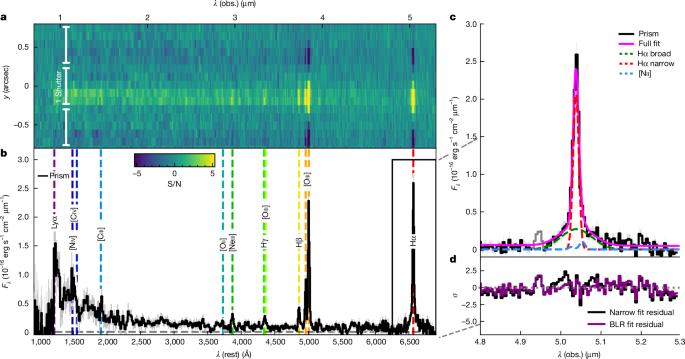早期宇宙中一个休眠的超大质量黑洞
IF 48.5
1区 综合性期刊
Q1 MULTIDISCIPLINARY SCIENCES
引用次数: 0
摘要
最近的观测发现,在大爆炸后的最初几亿年里,已经有大量的超大质量黑洞存在,与本地关系相比,其中许多黑洞相对于它们的宿主星系恒星质量似乎超重了。已经提出了几种不同的模型来解释这些发现,从重种子到经历高吸积率爆发的轻种子。然而,目前的数据集无法区分这些不同的情景。在这里,我们报告了JADES巡天中探测到的z = 6.68星系的宽Hα发射,该星系追踪到一个质量约为4 × 108M⊙的黑洞,其吸积速率仅为爱丁顿极限的0.02倍。黑洞与宿主星系恒星的质量比约为0.4,即约为局部关系的1000倍,而在宿主星系的动态质量和速度色散方面,该系统更接近局部关系。这个天体很可能是在再电离时期周围有大量休眠黑洞的迹象。它的性质与超级爱丁顿吸积的短暂爆发导致黑洞过度生长和吸积盘中大量气体排出的情况一致;在爆发之间,黑洞的大部分时间都处于休眠状态。一个处于高红移的休眠超大质量黑洞被发现,相对于它的宿主星系来说,它的质量实质上是过大的,这表明在再电离时代周围有更多的休眠黑洞。本文章由计算机程序翻译,如有差异,请以英文原文为准。

A dormant overmassive black hole in the early Universe
Recent observations have found a large number of supermassive black holes already in place in the first few hundred million years after the Big Bang, many of which seem to be overmassive relative to their host galaxy stellar mass when compared with local relation1–9. Several different models have been proposed to explain these findings, ranging from heavy seeds to light seeds experiencing bursts of high accretion rate10–16. Yet, current datasets are unable to differentiate between these various scenarios. Here we report the detection, from the JADES survey, of broad Hα emission in a galaxy at z = 6.68, which traces a black hole with a mass of about 4 × 108M⊙ and accreting at a rate of only 0.02 times the Eddington limit. The black hole to host galaxy stellar mass ratio is about 0.4—that is, about 1,000 times above the local relation—whereas the system is closer to the local relations in terms of dynamical mass and velocity dispersion of the host galaxy. This object is most likely an indication of a much larger population of dormant black holes around the epoch of reionization. Its properties are consistent with scenarios in which short bursts of super-Eddington accretion have resulted in black hole overgrowth and massive gas expulsion from the accretion disk; in between bursts, black holes spend most of their life in a dormant state. A dormant supermassive black hole at high redshift that is substantially overmassive relative to its host galaxy has been detected, indicating a much larger population of dormant black holes around the epoch of reionization.
求助全文
通过发布文献求助,成功后即可免费获取论文全文。
去求助
来源期刊

Nature
综合性期刊-综合性期刊
CiteScore
90.00
自引率
1.20%
发文量
3652
审稿时长
3 months
期刊介绍:
Nature is a prestigious international journal that publishes peer-reviewed research in various scientific and technological fields. The selection of articles is based on criteria such as originality, importance, interdisciplinary relevance, timeliness, accessibility, elegance, and surprising conclusions. In addition to showcasing significant scientific advances, Nature delivers rapid, authoritative, insightful news, and interpretation of current and upcoming trends impacting science, scientists, and the broader public. The journal serves a dual purpose: firstly, to promptly share noteworthy scientific advances and foster discussions among scientists, and secondly, to ensure the swift dissemination of scientific results globally, emphasizing their significance for knowledge, culture, and daily life.
 求助内容:
求助内容: 应助结果提醒方式:
应助结果提醒方式:


